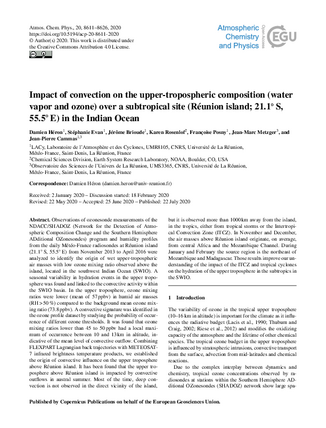
GCOS Reference Upper-Air Network
Title
Impact of convection on the upper-tropospheric composition (water vapor and ozone) over a subtropical site (Réunion island; 21.1° S, 55.5° E) in the Indian Ocean
Authors
Héron, D., Evan, S., Brioude, J., Rosenlof, K., Posny, F., Metzger, J.-M., and Cammas, J.-P.
Published
by Atmospheric Chemistry and Physics (ACP) at 2020-07-22
Abstract
Observations of ozonesonde measurements of the NDACC/SHADOZ (Network for the Detection of Atmospheric Composition Change and the Southern Hemisphere ADditional OZonesondes) program and humidity profiles from the daily Météo-France radiosondes at Réunion island (21.1∘ S, 55.5∘ E) from November 2013 to April 2016 were analyzed to identify the origin of wet upper-tropospheric air masses with low ozone mixing ratio observed above the island, located in the southwest Indian Ocean (SWIO). A seasonal variability in hydration events in the upper troposphere was found and linked to the convective activity within the SWIO basin. In the upper troposphere, ozone mixing ratios were lower (mean of 57 ppbv) in humid air masses (RH > 50 %) compared to the background mean ozone mixing ratio (73.8 ppbv). A convective signature was identified in the ozone profile dataset by studying the probability of occurrence of different ozone thresholds. It was found that ozone mixing ratios lower than 45 to 50 ppbv had a local maximum of occurrence between 10 and 13 km in altitude, indicative of the mean level of convective outflow. Combining FLEXPART Lagrangian back trajectories with METEOSAT-7 infrared brightness temperature products, we established the origin of convective influence on the upper troposphere above Réunion island. It has been found that the upper troposphere above Réunion island is impacted by convective outflows in austral summer. Most of the time, deep convection is not observed in the direct vicinity of the island, but it is observed more than 1000 km away from the island, in the tropics, either from tropical storms or the Intertropical Convection Zone (ITCZ). In November and December, the air masses above Réunion island originate, on average, from central Africa and the Mozambique Channel. During January and February the source region is the northeast of Mozambique and Madagascar. Those results improve our understanding of the impact of the ITCZ and tropical cyclones on the hydration of the upper troposphere in the subtropics in the SWIO.
Citation
Héron, D., Evan, S., Brioude, J., Rosenlof, K., Posny, F., Metzger, J.-M., and Cammas, J.-P.: Impact of convection on the upper-tropospheric composition (water vapor and ozone) over a subtropical site (Réunion island; 21.1° S, 55.5° E) in the Indian Ocean, Atmos. Chem. Phys., 20, 8611–8626, https://doi.org/10.5194/acp-20-8611-2020, 2020.
